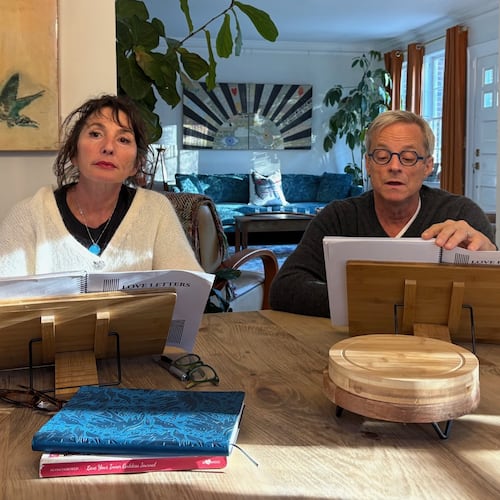Queer history is framed in ellipses. You just have to read with knowing eyes.
Jenn Shapland is determined to fill in those blanks in her sleek, elegant first book, “My Autobiography of Carson McCullers.” It is both a memoir of her own coming-out and a nuanced exploration of her magnificent obsession with the Georgia author known for her sensitive portrayals of misfits.
“Many of the details of Carson’s lesbian life are right there, in plain sight. It’s just that they are housed within another narrative: the straight narrative, the one in which inexplicable crushes on and friendships with women surface briefly within the confines of an otherwise ‘normal’ life,” writes Shapland.
Now based in New Mexico, Shapland was working as an intern in the Harry Ransom Center, a collection of documents at the University of Texas, when she stumbled across a letter that raised her eyebrows. It was a fulsome note to McCullers from Annmarie Clarac-Schwarzenbach, a glamorous Swiss silk heiress known for seducing women and “not wearing a brassiere.” It reads: “Carson, child, my beloved, you know that, leaving the day after tomorrow, feeling half-afraid and proud, leaving behind me all I care for once again, and a wave of love … “
In response, Shapland mused, “I had received letters like these. I had written letters like these to the women I’d loved. It was very little to go on, and yet I felt an utter certainty: Carson McCullers had loved women.”
For decades, the sexual orientation of McCullers, who died in 1967, has been a question mark, with scant evidence to prove anything definitively, one way or the other. She married and divorced the same man twice, and friends characterized her stints with Reeves McCullers as “tortured.”
Born in Columbus, Lula Carson Smith was a frail, wide-eyed waif who looks poignant and pensive in just about every extant photograph. Her debut novel, “The Heart is a Lonely Hunter,” published when she was 23, was a literary sensation. She went on to write seven other books, including “Reflections in a Golden Eye” (dedicated to Clarac-Schwarzenbach), “The Member of the Wedding,” and the novella “The Ballad of the Sad Café.” She made the bohemian rounds, retreating to Yaddo, hanging out with Tennessee Williams and shacking up with luminaries such as W.H. Auden and Paul Bowles in the fabled “February House” commune in New York. She suffered several strokes; she drank too much. Above all, McCullers wrote with marked sensitivity, humanity and originality.
Shapland’s enthrallment came at a fortuitous time. For psychological therapy, McCullers had consulted with Dr. Mary Mercer, who preserved her records with the caveat that they not be released until after her death. The transcripts surfaced in 2014 and wound up at Columbus State University.
Shapland made a beeline there and devoured every jotting.
McCullers had been nervous about starting therapy in 1958, but she saw it as a tool for memoir. In her second autobiography, “Illumination and Night Glare,” dictated from her sick-bed and published posthumously, she recalls worrying that “Dr. Mercer would be ugly, bossy and try to invade my soul’s particular territories.” Instead, she quickly concluded that the doctor “was and is the most beautiful woman I’ve ever seen” and started addressing her as “heartchild,” and signing her moony letters with “I kiss your little foot.”
Shapland moved into the artist-in-residence apartment in McCullers’ homeplace on Stark Avenue in Columbus, the better to ruminate over the talismanic objects preserved in the museum part of the house. She caresses McCullers’ kimonos, sits in her favorite blue chair and takes long soaks in her bath — literally immersing herself in the world of her kindred spirit. In her research, she learns about other women who were important to the author: her piano teacher, Gypsy Rose Lee, a student she courted with homemade fudge. But Dr. Mercer appears to have been the love of her life. Doctor and patient traveled together and presented the dynamic of a couple; McCullers left her psychologist a third of her estate.
All of this Sapphic intensity emboldened Shapland herself to step out of the closet. She cut her hair as part of this declaration. No more joyless affairs with male professors, no more girlfriends described as “roommates.” She found some old love letters and in them found herself.
Another aspect of McCullers that resonates with Shapland: illness. McCullers had suffered rheumatic fever that left her heart weak, and Shapland, too, has a cardiac defect. They both have produced much of their writing in bed. “I think this is one thing that drew me to Carson’s fiction in the first place. … Carson is at pains to articulate the inarticulable to find a way to express feelings of isolation, loneliness, and longing that I associate with queer life, with life as a sick person, and with life as a writer,” Shapland writes.
“My Autobiography of Carson McCullers” is rendered in taut, short, spiky chapters. Shapland plainly feels possessive and protective of McCullers. The final chapter is titled “Euphemisms”: “To her husband, whom she married twice, Carson called her woman lovers ‘imaginary friends.’ Her biographers called them traveling companions, good friends, roommates, close friends, dear friends, obsessions, crushes, special friends. I’m over it. I, for one, am weary of the refusal to acknowledge what is plainly obvious, plainly wonderful. Call it love.”
Planting her rainbow flag in this Southern Gothic territory, Shapland makes a rousing and compelling case. It is time we bring McCullers to a new generation of readers, in a fresh light.
About the Author
Keep Reading
The Latest
Featured


